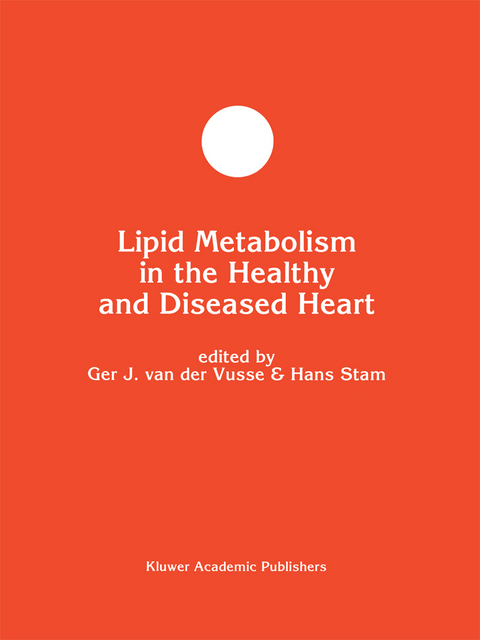
Lipid Metabolism in the Healthy and Disease Heart
Springer-Verlag New York Inc.
978-1-4613-6559-4 (ISBN)
The discovery of the second-messenger functions of on serine and threonine residues. Although there is inositol 1,4,5-trisphosphate (Ins(1 ,4,5)P 3) and 1,2-dia- general agreement that PKC plays an important role in cylglycerol (DAG), the products of receptor-stimulated the initiation and/or modulation of receptor-linked re- phosphatidylinositol 4,5-bisphosphate (PtdIns( 4,5)P ) 2 sponses, the precise nature or molecular details of this hydrolysis, marked a turning point in the studies on the involvement remain elusive. There are several sugges- mechanisms of mediation of functional hormone and tions of possible functions of PKC, including involve- neurotransmitter responses. The historical background ment in modulation of ionconductance, regulation of of this discovery and the extensive bibliography of the receptor interaction with components of (other) signal 2 enormously expanding knowledge in this field was re- transduction pathways, modulation of Ca + sensitivity cently presented by Rana and Hokin [1], the latter of contractile proteins and gene expression [6]. author who first observed the 'phosphoinositide' effect The receptors involved in the activation of the adeny- 35 years ago.
It was, however, the Ca2+ gating hypothe- late cyclase and PtdIns cascade pathways have one com- sis proposed by Michell [2] on basis of a survey of mon feature. They are present in the plasmamembrane observations on the phosphoinositide turnover in a as complexes with GTP binding proteins (G-proteins).
Paradoxical role of lipid metabolism in heart function and dysfunction.- Interrelationship between lactate and cardiac fatty acid metabolism.- Dietary modulation of lipid metabolism and mechanical performance of the heart.- The substrate specificity of phosphoinositide-phospholipase C in rat heart sarcolemma.- Long term incubation of cardiac myocytes with oleic acid and very-low density lipoprotein reduces heparin-releasable lipoprotein lipase activity.- Carnitine palmitoyltransferase in the heart is controlled by a different mechanism than the hepatic enzyme.- Myocardial cell vulnerability to exogenous phospholipase attack.- Phosphatidylcholine metabolism in ischemic and hypoxic hearts.- Occurrence and functions of the phosphatidylinositol cycle in the myocardium.- Modulation of phosphatidylethanolamine biosynthesis by exogenous ethanolamine and analogues in the hamster heart.- Eicosapentaenoic and docosahexaenoic cultured rat ventricular myocytes and hypoxia-induced alterations of phospholipase-A activity.- Incorporation of radioiodinated fatty acids into cardiac phospholipids of normoxic canine myocardium.- Kinetic changes of ethanolamine base exchange activity and increase of viscosity in sarcolemmal membranes of hamster heart during development of cardiomyopathy.- Annexins in cardiac tissue: cellular localization and effect on phospholipase activity.- Myocardial fatty acid oxidation during ischemia and reperfusion.- The relative contribution of glucose and fatty acids to ATP production in hearts reperfused following ischemia.- Effects of palmitoyl CoA and palmitoyl carnitine on the membrane potential and Mg2{+} content of rat heart mitochondria.- Carnitine requirement of vascular endothelial and smooth muscle cells in imminent ischemia.- Protection of the ischemicdiabetic heart by L-propionylcarnitine therapy.- Functional and metabolic effects of propionyl-L-carnitine in the isolated perfused hypertrophied rat heart.- L- propionylcarnitine and myocardial performance in stunned porcine myocardium.- Release of heart fatty acid-binding protein into plasma after acute myocardial infarction in man.- Regulatory functions of the coronary endothelium.- Lipid metabolism of myocardial endothelial cells.- Endothelium, the dynamic interface in cardiac lipid transport.- Malondialdehyde is a biochemical marker of peroxidative damage in the isolated reperfused rat heart.- Studies on the interaction of leucocytes and the myocardial vasculature. I. Effect of hypoxia on the adherence of blood granulocytes.- Arachidonic acid incorporation in cardiomyocytes, endothelial cells and fibroblast-like cells isolated from adult rat heart.
| Reihe/Serie | Developments in Molecular and Cellular Biochemistry ; 8 |
|---|---|
| Zusatzinfo | 213 p. |
| Verlagsort | New York, NY |
| Sprache | englisch |
| Maße | 210 x 280 mm |
| Themenwelt | Medizinische Fachgebiete ► Innere Medizin ► Kardiologie / Angiologie |
| Naturwissenschaften ► Biologie ► Biochemie | |
| ISBN-10 | 1-4613-6559-7 / 1461365597 |
| ISBN-13 | 978-1-4613-6559-4 / 9781461365594 |
| Zustand | Neuware |
| Haben Sie eine Frage zum Produkt? |
aus dem Bereich


